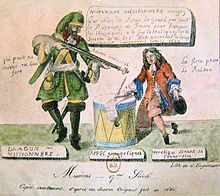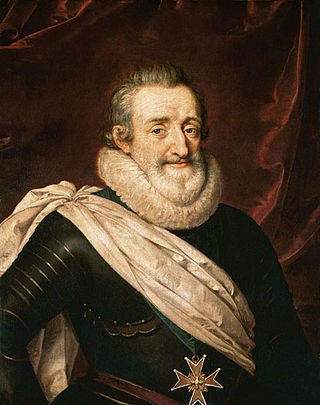
The Edict of Nantes was signed in April 1598 by King Henry IV and granted the minority Calvinist Protestants of France, also known as Huguenots, substantial rights in the nation, which was predominantly Catholic.

The Huguenots were a religious group of French Protestants who held to the Reformed (Calvinist) tradition of Protestantism. The term, which may be derived from the name of a Swiss political leader, the Genevan burgomaster Besançon Hugues (1491–1532), was in common use by the mid-16th century. Huguenot was frequently used in reference to those of the Reformed Church of France from the time of the Protestant Reformation. By contrast, the Protestant populations of eastern France, in Alsace, Moselle, and Montbéliard, were mainly Lutherans.

The French Wars of Religion were a series of civil wars between French Catholics and Protestants from 1562 to 1598. Between two and four million people died from violence, famine or disease directly caused by the conflict, and it severely damaged the power of the French monarchy. One of its most notorious episodes was the St. Bartholomew's Day massacre in 1572. The fighting ended with a compromise in 1598, when Henry of Navarre, who had converted to Catholicism in 1593, was proclaimed King Henry IV of France and issued the Edict of Nantes, which granted substantial rights and freedoms to the Huguenots. However, Catholics continued to disapprove of Protestants and of Henry, and his assassination in 1610 triggered a fresh round of Huguenot rebellions in the 1620s.

François Michel Le Tellier, Marquis de Louvois was the French Secretary of State for War during a significant part of the reign of Louis XIV. He is commonly referred to as "Louvois". Together with his father, Michel le Tellier, he oversaw an increase in the numbers of the French Army, eventually reaching 340,000 soldiers – an army that would fight four wars between 1667 and 1713. Louvois was a key military and strategic advisor to Louis XIV, who transformed the French Army into an instrument of royal authority and foreign policy.

The Edict of Fontainebleau was an edict issued by French King Louis XIV and is also known as the Revocation of the Edict of Nantes. The Edict of Nantes (1598) had granted Huguenots the right to practice their religion without state persecution. Protestants had lost their independence in places of refuge under Cardinal Richelieu on account of their supposed insubordination, but they continued to live in comparative security and political contentment. From the outset, religious toleration in France had been a royal, rather than popular, policy.
Camisards were Huguenots of the rugged and isolated Cévennes region and the neighbouring Vaunage in southern France. In the early 1700s, they raised a resistance against the persecutions which followed Louis XIV's Revocation of the Edict of Nantes, making Protestantism illegal. The Camisards operated throughout the mainly Protestant Cévennes and Vaunage regions including parts of the Camargue around Aigues Mortes. The revolt broke out in 1702, with the worst of the fighting continuing until 1704, then skirmishes until 1710 and a final peace by 1715. The Edict of Tolerance was not finally signed until 1787.

René de Froulay, Count of Tessé was a French soldier and diplomat during the reign of Louis XIV and the 1715–1723 Regency.
The secretary of state for protestant affairs, was the secretary of state in France during the "Ancien Régime" and Bourbon Restoration in charge of overseeing French Protestant affairs. From 1749 on, the position was combined with the position of secretary of state of the Maison du Roi.
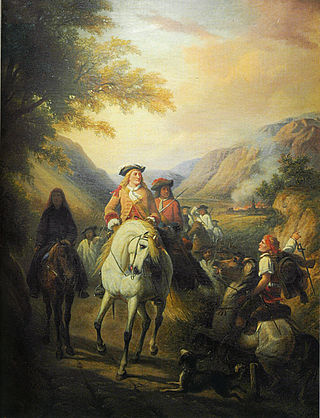
The War of the Camisards or the Cévennes War was an uprising of Protestant peasants known as Camisards in the Cévennes and Languedoc during the reign of Louis XIV. The uprising was a response to the Edict of Fountainebleu in 1685.

The persecution of Huguenots under Louis XV refers to hostile activities against French Protestants between 1715 and 1774 during the reign of Louis XV.

Protestantism in France has existed in its various forms, starting with Calvinism and Lutheranism since the Protestant Reformation. John Calvin was a Frenchman, as were numerous other Protestant Reformers including William Farel, Pierre Viret and Theodore Beza, who was Calvin's successor in Geneva. Peter Waldo was a merchant from Lyon, who founded a pre-Protestant group, the Waldensians. Martin Bucer was born a German in Alsace, which historically belonged to the Holy Roman Empire, but now belongs to France.
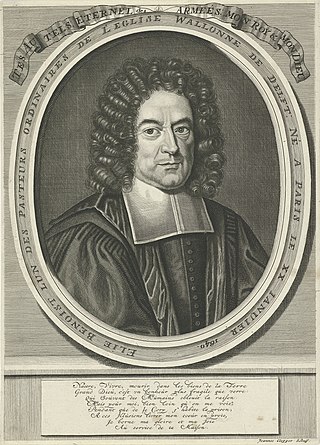
Élie Benoist, was a French Protestant minister, known as a historian of the Edict of Nantes.

The Huguenot rebellions, sometimes called the Rohan Wars after the Huguenot leader Henri de Rohan, were a series of rebellions of the 1620s in which French Calvinist Protestants (Huguenots), mainly located in southwestern France, revolted against royal authority. The uprising occurred a decade after the death of Henry IV who, himself originally a Huguenot before converting to Catholicism, had protected Protestants through the Edict of Nantes. His successor Louis XIII, under the regency of his Italian Catholic mother Marie de' Medici, became more intolerant of Protestantism. The Huguenots responded by establishing independent political and military structures, establishing diplomatic contacts with foreign powers, and openly revolting against central power. The Huguenot rebellions came after two decades of internal peace under Henry IV, following the intermittent French Wars of Religion of 1562–1598.

Daniel de Superville, also known as Daniel de Superville père, was a Huguenot pastor and theologian who fled France for the Dutch Republic in 1685 and became the minister of the Walloon church in Rotterdam. He is known particularly for his published Sermons.

Michel Le Tellier, marquis de Barbezieux, seigneur de Chaville et de Viroflay was a French statesman.

The Edict of Versailles, also known as the Edict of Tolerance, was an official act that gave non-Catholics in France the access to civil rights formerly denied to them, which included the right to contract marriages without having to convert to the Catholic faith, but it denied them political rights and public worship. The edict was signed by King Louis XVI on 7 November 1787, and registered in the Parlement of Paris during the Ancien Régime on 29 January 1788. Its successful enactment was caused by persuasive arguments by prominent French philosophers and literary personalities of the day, including Anne-Robert-Jacques Turgot; Étienne François, duc de Choiseul, Americans such as Benjamin Franklin and especially the joint work of Guillaume-Chrétien de Lamoignon de Malesherbes, minister to Louis XVI, and Jean-Paul Rabaut Saint-Étienne, spokesman for the Protestant community in France.
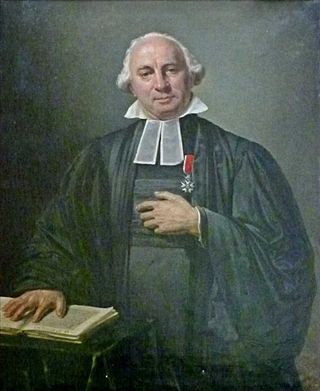
Paul-Henri Marron was the first Reformed pastor in Paris following the French Revolution. Born in the Netherlands to a Huguenot family, Marron first came to Paris as the chaplain of the Dutch embassy. Protestants in France had been prohibited from worshipping openly since the Revocation of the Edict of Nantes in 1685. The Edict of Tolerance in 1787 gave non-Catholics the right to openly practice their religion. Marron was recruited to lead the newly tolerated Protestant community of Paris, a task he accomplished through the French Revolution, several imprisonments, the Napoleonic Wars, the Bourbon Restoration and into the July Monarchy.
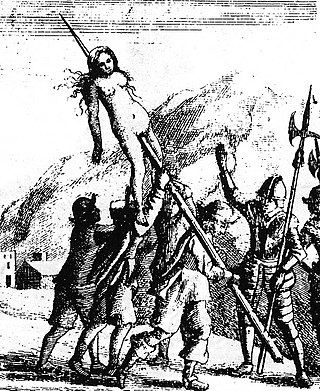
The Savoyard–Waldensian wars were a series of conflicts between the community of Waldensians and the Savoyard troops in the Duchy of Savoy from 1655 to 1690. The Piedmontese Easter in 1655 sparked the conflict. It was largely a period of persecution of the Waldensian Church, rather than a military conflict. Joshua Janavel (1617–1690) was one of the Waldensian military leaders against the Savoyard ducal troops.

Jacques Saurin was a major French religious figure in the late 17th century and early 18th century who was particularly well-known as a preacher. While he began his career as a Catholic priest, Saurin ultimately converted and became a pastor of the Reformed Church of France.
The massacre at Agau mill was a massacre of Huguenots near Nîmes on 1 April 1703 perpetrated by Royal French forces during the War of the Camisards.

